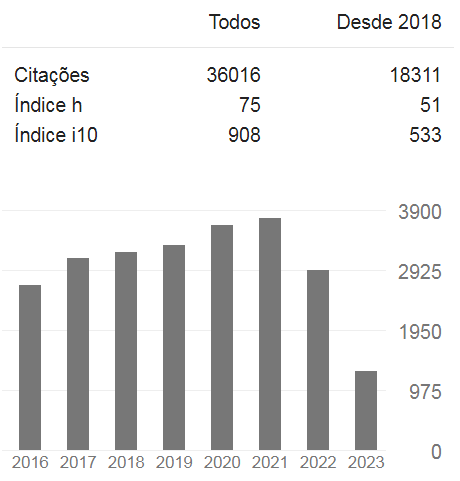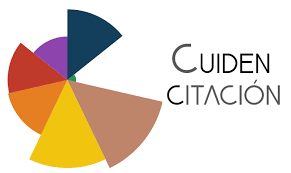Epidemiological profile of patients with facial injuries treated in an emergency hospital
DOI:
https://doi.org/10.5935/1415-2762.20160005Keywords:
Emergency Service, Hospital, Health Profile, Patients, Facial InjuriesAbstract
This research aimed to identify the characteristics of patients suffering from craniofacial trauma seen in the emergency unit of a teaching hospital in the state of São Paulo. Treatment is a retrospective, descriptive and analytical study with a quantitative approach. Data were obtained from medical records, in the period from 2011 to 2014. The sample consisted of 867 patients. The characteristics of the study population showed that 60.9% were male, 66.8% were aged 0-20 years old, 87% were white, 55.5% were in the city of São José do Rio Preto, 79.6% were inactive, 84.8% had no partner and 52.7% level of education were illiterate. Studies in North America show that falls are the leading cause of non-fatal injuries to children and adolescents up to 19 years old. The higher incidence of trauma was the falling with 74.1%, the craniofacial trauma with 75.7% and more frequent when compared to facial trauma with 24.2%. The occurrence of exams was 19.7%, dressings with 6.5%, 6.3% suture, 23.9% medication and 0.7% surgical procedures. It is concluded that the facial trauma were more common in the age group between 21 and 60 years old, active patients, with a partner and higher education. The main causes were physical aggression, syncope/seizure. The craniofacial trauma was more frequent between the ages of 0 and 20 years old and with more than 60 years old, retired, unmarried and illiterate, with the fall as the leading cause.
References
Calil AM, Sallum EA, Domingues CA, Nogueira LS. Mapeamento das lesões em vítimas de acidentes de trânsito: revisão sistemática da literatura. Rev Latino-Am Enferm. 2009[citado em 2014 abr 11];17(1):120-5. Disponível em: http://dx.doi.org/10.1590/S0104-11692009000100019.
Calil AM. Avaliação da dor e analgesia no atendimento pré-hospitalar em pacientes de trauma. Rev Gaúcha Enferm. 2008[citado em 2014 abr 11];29(2):308-13. Disponível em: http://seer.ufrgs.br/RevistaGauchadeEnfermagem/article/viewFile/5596/3206
Vieira CL, Araújo DCC, Ribeiro MLS, Laureano Filho JR. Lesão de tecido mole em pacientes vítimas de trauma buco-maxilo-facial. Rev Cir Traumatol Buco-Maxilo-Fac. 2013[citado em 2014 abr 25];13(1):[cerca de 8 p.]. Disponível em: http://revodonto.bvsalud.org/scielo.php?script=sci_arttext&pid=s1808-52102013000100015&lng=p&nrm=iso.
Gonzaga F. Estudo dos traumas de face atendidos e tratados cirurgicamente no hospital regional de São José Dr. Homero de Miranda Gomes, no ano de 2012 [monografia]. Florianópolis: Universidade Federal de Santa Catarina; 2013.
Carvalho TBO, Cancian LRL, Marques CG, Piatto VB, Maniglia JV, Molina FD. Seis anos de atendimento em trauma facial: análise epidemiológica de 355 casos. Braz J Otorhinolaryngol. 2010[citado em 2014 abr 11];76(5):565-74. Disponível em: http://dx.doi.org/10.1590/S1808-86942010000500006.
Salvador PTCO, Alves KYA, Martins CCF, Santos VEP, Tourinho FSV. Perfil das dissertações e teses brasileiras acerca do trauma: uma pesquisa documental. Rev Col Bras Cir. 2012[citado em 2014 abr 11];39(4):328-34. Disponível em: http://dx.doi.org/10.1590/S0100-69912012000400014.
Braga Junior MB, Chagas Neto FA, Porto MA, Barroso TA, Lima ACM, Silva SM, et al. Epidemiologia e grau de satisfação do paciente vítima de trauma músculo-esquelético atendido em hospital de emergência da rede pública brasileira. Acta Ortop Bras. 2005[citado em 2014 abr 11];13(3):137-40. Disponível em: http://dx.doi.org/10.1590/S1413-78522005000300007.
Santos MS, Almeida TF, Silva TF. Traumas faciais: perfil epidemiológico com ênfase nas características sociais e demográficas e características da lesão, Salvador, BA, 2008. Rev Baiana Saúde Pública. 2013[citado em 2014 abr 11];37(4):1003-14. Disponível em: http://inseer.ibict.br/rbsp/index.php/rbsp/article/view/536
Scannavino FLF, Santos FS, Novo Neto JP, Novo LP. Análise epidemiológica dos traumas bucomaxilofaciais de um serviço de emergência. Rev Cir Traumatol Buco-Maxilo-Fac. 2013[citado em 2014 abr 11];13(4):95-100. Disponível em: http://www.revistacirurgiabmf.com/2013/4/14.pdf
Costa MCF. Traumas faciais em mulheres vítimas de violência em Campina Grande-PB [monografia]. Campina Grande: Universidade Estadual da Paraíba; 2012.
Gonzaga F. Estudo dos traumas de face atendidos e tratados cirurgicamente no hospital regional de São José Dr. Homero de Miranda Gomes, no ano de 2012 [monografia]. Florianópolis: Universidade Federal de Santa Catarina; 2013.
Rao S, Raghani MJ. Cranio-maxillofacial injuries in polytrauma patients. J Orthop Traumatol Rehabil. 2013[citado em 2014 abr 11];6(1):44-6. Disponível em: http://www.jotr.in/article.asp?issn=0975-7341;year=2013;volume=6;issue=1;spage=44;epage=46;aulast=Rao Doi: 10.4103/0975-7341.118753
Siqueira EJ, Alvarez GS, Bolson PB, Oliveira MP. Abordagem multidisciplinar do trauma facial grave. Rev AMRIGS. 2014[citado em 2015 abr 11];58(4):275-80. Disponível em: http://www.amrigs.org.br/revista/58-04/0000106068-03_1258_Revista%20AMRIGS.pdf
Cavalcanti CDK, Ilha P, Bertoncello KCG. O cuidado de enfermagem a vítimas de traumas múltiplos: uma revisão integrativa. UNOPAR Cient Ciênc Biol Saúde. 2013[citado em 2015 abr 11];15(1):81-8. Disponível em: http://www.pgsskroton.com.br/seer/index.php/biologicas/article/viewFile/800/765
Polit DF, Beck CT, Hungler BP. Fundamentos de pesquisa em enfermagem: métodos, avaliação e utilização. 5ª ed. Porto Alegre: Artes Médicas; 2004.
Santos FS, Casagranda LP, Lange C, Farias JC, Pereira PM, Jardim VM, et al.Traumatismo cranioencefálico: causas e perfil das vítimas atendidas no pronto-socorro de Pelotas/Rio Grande do Sul, Brasil. REME - Rev Min Enferm. 2013[citado em 2015 abr 11];17(4):888-93. Disponível em: http://www.reme.org.br/artigo/detalhes/893. Doi: 10.5935/1415-2762.20130064
Allareddy V, Itty A, Maiorini E, Lee MK, Rampa S, Allareddy V, et al. Emergency department visits with facial fractures among children and adolescents: an analysis of profile and predictors of causes of injuries. J Oral Maxillofac Surg. 2014[citado em 2014 abr 11];72(9):1756-65. Disponível em: http://www.joms.org/article/S0278-2391(14)00328-0/fulltext. Doi: 10.1016/j.joms.2014.03.015.
Mascarenhas MDM, Malta DC, Silva MMA, Carvalho CG, Monteiro RA, Morais Neto OL. Consumo de álcool entre vítimas de acidentes e violências atendidas em serviços de emergência no Brasil, 2006 e 2007. Ciênc Saúde Coletiva. 2009[citado em 2014 abr 11];14(5):1789-96. Disponível em: http://dx.doi.org/10.1590/S1413-81232009000500020.
Wulkan M, Parreira Junior JG, Botter DA. Epidemiologia do trauma facial. Rev Assoc Med Bras. 2005 [citado em 2015 abr 11];51(5):290-5. Disponível em: http://dx.doi.org/10.1590/S0104-42302005000500022.
Macedo JLS, Camargo LM, Almeida PF, Rosa SC. Perfil epidemiológico do trauma de face dos pacientes atendidos no pronto socorro de um hospital público. Rev Col Bras Cir. 2008[citado em 2015 abr 11];35(1):9-13. Disponível em: http://dx.doi.org/10.1590/S0100-69912008000100004.
Moura EC, Gomes R, Falcão MTC, Schwarz E, Neves ACM, Santos W. Desigualdades de gênero na mortalidade por causas externas no Brasil, 2010. Ciênc Saúde Coletiva. 2015[citado em 2014 abr 11];20(3):779-88. Disponível em: http://dx.doi.org/10.1590/1413-81232015203.11172014.;20(3):779-88.
Braz M. A construção da subjetividade masculina e seu impacto sobre a saúde do homem: reflexão bioética sobre justiça distributiva. Ciênc Saúde Coletiva. 2005[citado em 2015 abr 11];10(1):97-104. Disponível em: http://www.scielo.br/pdf/csc/v10n1/a10v10n1.pdf
Ministério da Educação (BR). Portal Brasil. Censo 2010. [citado 2015 jun 02]; [cerca de 3 telas]. Disponível em: http://www.brasil.gov.br/educacao/2012/07/censo-2010-mostra-as-diferencas-entre-caracteristicas-gerais-da-populacao-brasileira.
Ministério da Saúde (BR). DATASUS. Morbidade hospitalar do SUS por causas externas - por local de internação - São Paulo. [citado em 2015 jun 02]; [cerca de 2 telas]. Disponível em: http://tabnet.datasus.gov.br/cgi/tabcgi.exe?sih/cnv/fisp.def.
Mangram AJ, Horan TC, Pearson ML, Silver LC, Jarvis WR. Guideline for prevention of surgical site infection, 1999. Infect Control Hosp Epidemiol. 1999[citado em 2015 jun 03];20(4):[cerca de 32 p.]. Disponível em: http://www.cdc.gov/hicpac/pdf/guidelines/SSI_1999.pdf.
Downloads
Published
Issue
Section
License
Copyright (c) 2017 Reme: Revista Mineira de Enfermagem

This work is licensed under a Creative Commons Attribution 4.0 International License.






































